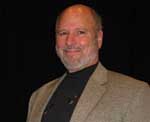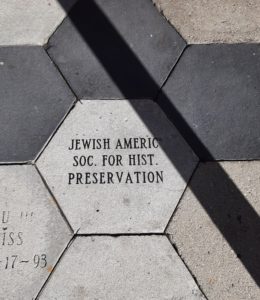By Jerry Klinger

YBOR CITY, Florida — It’s a simple, small concrete gray hexagonal paver. The words Jewish American Society for Historic Preservation, contracted for line count restrictions, are etched in a slightly off-centered recess.
The paver is on the sidewalk, in front of the former Buchman store at 1910 E. 7th Ave., Ybor City, Florida. Buchman was a German Jewish immigrant, who like many of his compatriots, along with later Russian and Romanian immigrants, were the backbone of Ybor City’s mercantile establishment.
Pavers can be purchased by anyone from the Ybor City buy a paver program. Inscriptions can be for most anything. The funds go to the city to help, preserve, interpret, and encourage tourism.

Ybor today is an eclectic city of fun, delicious eats, music, arts, and history with the sweet aroma of a good hand-rolled cigar still very faintly lingering in the air. It is part of greater Tampa.
Seeing the paver for most is a shrug; oh, there must have been Jews here. Perhaps they will open their cell phones and Google, Jews, Ybor City.
Well, that is the hope.
Yes, there is a Jewish story behind the paver. Jews did not show up yesterday. They have been part and parcel of the American tapestry, even if few in number from the very beginnings.
The first known Jew to live in the area was a real Ashet Hayil, Emmaline Quentz Miley, 1846. She was a force to be reckoned with.
Emmaline was born and grew up in South Carolina. When it was time to consider her future and marriage, a young Scotsman, William Goodman Miley, came a-courting.
Miley was more than taken with Emmaline. But Emmaline had a condition he must do before she would consent to marry him…and it was not converting. Emmaline required that Miley sell all his slaves. Emmaline had a deep hatred for slavery.
Emmaline married William. They moved to the wilds of thinly populated Western Florida, just north of Ybor City. Her neighbors were hostile Seminole Indians, and mosquitoes the size of fists. There would be nowhere to buy a good bagel for another 100 years. The Mileys settled in, made friends with the locals, and raised cattle. They had 12 children, enough for a minyan if needed.
The future Tampa Bay area was a backwater’s backwater until an American railroad entrepreneur, Henry Plant, recognized the area’s excellent natural harborage. Tampa could be a terminus for a rail line to the interior of Florida linking the Florida Keys and the West Coast of Florida’s Gulf of Mexico to Cuba and Latin America. There was opportunity. There was risk.
Plant’s 1885 gutsy bet on Tampa paid off big time. Almost overnight, Tampa grew. What really pushed Tampa to grow…cigars.
In 1886 an entrepreneurial-minded Spaniard, Vincente Martinez-Ybor was scouting for a new manufacturing site for his hand rolled cigar business. He had successfully established manufacturing sites in Cuba and Key West. He wanted a fresh start location away from the revolutionary turmoil constantly gripping Cuba and the labor tensions of Key West.
Ybor opened negotiations to buy 40 acres of land but got nowhere but frustration. He was almost ready to board the train for a new potential site, Jacksonville, when he was stopped by a delegation from the Tampa Board of Trade.
With the delegation supporting Ybor, land was purchased. Ybor set about building his hand-rolled cigar business. He built a company city, complete with housing that was uniquely owned by his business’ labor pool. Ybor city, as it was called, boomed. Ybor City and the Tampa area became the Cigar Capital of the World.
Ybor City might not have been built. The Board of Trade delegation is believed to have included Tampa’s biggest booster, Herman Glogowski, a Yiddish boy, a German Jew. Glogowsky, in 1886, was for the first of four different times, elected mayor of Tampa. He oversaw and directed the infrastructure and growth of Florida’s west coast metropolis. He was a co-founder of Tampa’s first permanent Jewish house of Worship, Shaare Zedek.
Work in Ybor City’s cigar business paid good money. Labor flooded in, Cubans, Spanish, Americans, White and Black, Italians, Greeks, Chinese, Jews, notably Romanian and German Jews with a spattering of Russian/Polish Jews.
Like Glogowsky, the Jews were entrepreneurial. Within 20 years Jews became the mercantile backbone of Ybor City. Scores of Jewish owned businesses grew up. They expanded and seeded economic growth with significant social and political benefits to Tampa.
Many of the Jews had been recent refugees from lands that hated them for being Jews. They were welcomed to the new land of America that measured them first on what they could do rather than who they were. As the Jews of Ybor, Tampa, and Florida benefited by the freedom of their acceptance, America benefited richly too.
Ybor City has a very unusual park. It is an honorary memorial park to the early Cuban revolutionary liberator Jose Marti. Marti was a journalist who wrote extensively about the horrific oppression of Russian Jews.
Marti came to Ybor City looking for financial support and even military volunteers. The Jews stepped up.
The memorial park to Marti is unusual in the U.S. It is owned by the government of Cuba.
The Jewish American Society for Historic Preservation has completed projects in 40 states and in six countries. Some of the projects are very large, others are very small, like the paver efforts.
Pavers and or bricks are small. The word Jew or Jewish can be big, certainly when discovered unexpectedly. The paver projects are another notch in the ever-necessary vigilance against blind bigotry, ignorance, and antisemitism.
How successful will the paver projects be? That is unknown. What is known is that doing nothing but being a fly on the wallpaper of history is the fly only gets swatted.
*
Jerry Klinger is the President of the Jewish American Society for Historic Preservation, www.JASHP.org